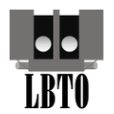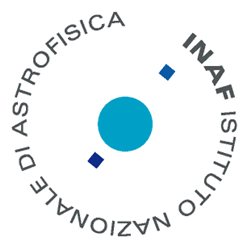LBT Instruments Overview
| Instrument | Type | Wavelength | AO | |
|---|---|---|---|---|
| VIS | LBC-B (Left) | Wide Field Imager | 350 – 650 nm | |
| LBC-R (Right) | Wide Field Imager | 550 – 1000 nm | ||
| MODS 1 (Left) | Imager / Spectrograph | 320 – 1100 nm | ||
| MODS 2 (Right) | Imager / Spectrograph | 320 – 1100 nm | ||
| PEPSI | Spectrograph / Polarimeter | 383 – 907 nm | ||
| SHARK-VIS | Broad/Narrow band Imager, Spectral Differential Imaging, Coronagraph | 400 – 900 nm | ✔ | |
| NIR/MIR | LUCI1 (Left) | Imager / Spectrograph | 890 – 2440 nm | ✔ |
| LUCI2 (Right) | Imager / Spectrograph | 960 – 2440 nm | ✔ | |
| LMIRCAM | Imager / Coronagraph | 3-5 μm | ✔ | |
| NOMIC | Imager | 8-13 μm | ✔ | |
| SHARK-NIR | Imager / Spectrograph / Coronagraph | 0.95-1.7 μm | ✔ |
For the detailed status of the observing modes offered for each instrument, please refer to the LBTO call for proposal page available here.
LBC-BLUE, LBC-RED
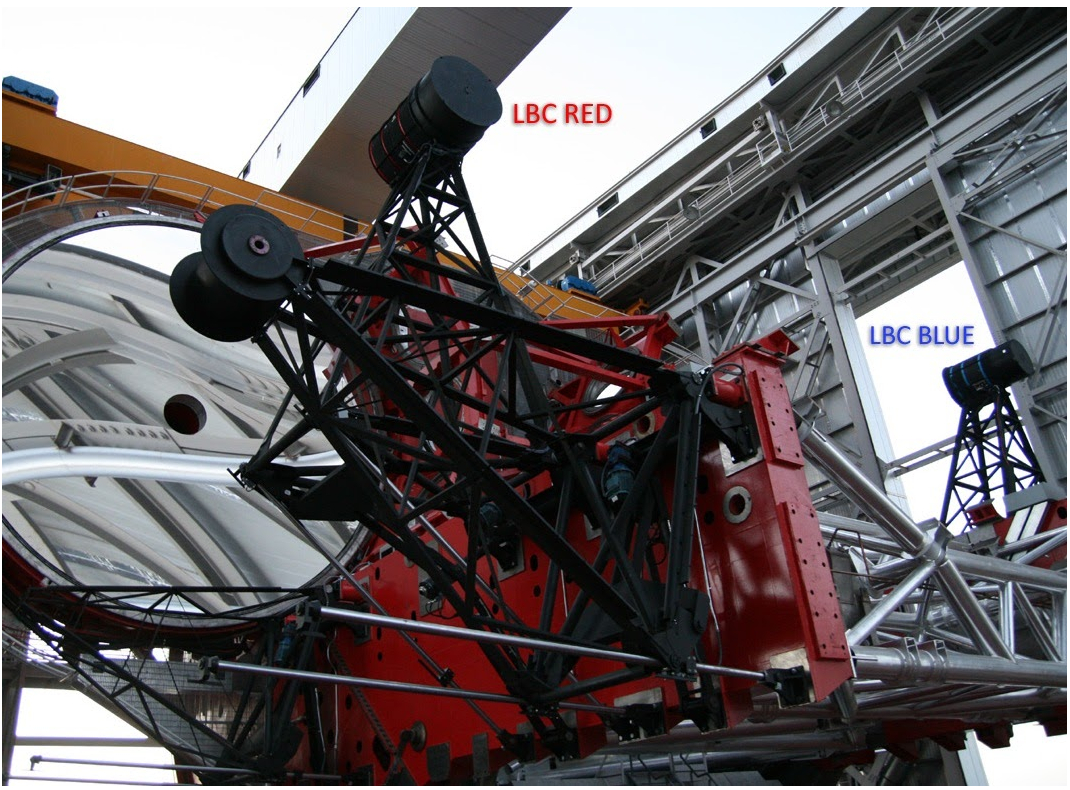 The Large Binocular Camera (LBC) is the double optical imager installed at the prime foci of the Large Binocular Telescope. LBC is composed by two separated large field cameras, one optimized for the UBV bands (LBC-B) and the second for the VRIZ bands (LBC-R). An optical corrector balances the aberrations induced by the fast (F#=1.14) parabolic primary mirror of LBT, assuring that the 80% of the PSF encircled energy falls inside one pixel. The two channels have similar optical designs satisfying the same requirements, but differ in the lens glasses: fused silica for the "blue" arm and BK7 for the "red" one. The two focal plane cameras use an array of four 4290 chips (4.5x2 K) provided by E2Vi optimized for the maximum quantum efficiency (85%) in each channel. The arrays are cooled by LN2 cryostats assuring 24 hours of operation. A summary of the capabilities of the two cameras is given in the table below.
The Large Binocular Camera (LBC) is the double optical imager installed at the prime foci of the Large Binocular Telescope. LBC is composed by two separated large field cameras, one optimized for the UBV bands (LBC-B) and the second for the VRIZ bands (LBC-R). An optical corrector balances the aberrations induced by the fast (F#=1.14) parabolic primary mirror of LBT, assuring that the 80% of the PSF encircled energy falls inside one pixel. The two channels have similar optical designs satisfying the same requirements, but differ in the lens glasses: fused silica for the "blue" arm and BK7 for the "red" one. The two focal plane cameras use an array of four 4290 chips (4.5x2 K) provided by E2Vi optimized for the maximum quantum efficiency (85%) in each channel. The arrays are cooled by LN2 cryostats assuring 24 hours of operation. A summary of the capabilities of the two cameras is given in the table below.
More information can be found here.
| FOV | Scale | Filters | |
|---|---|---|---|
| LBC-BLUE | 23'x 25' | 0.225"/pix | UBessel, BBessel, VBessel, gsloan, rsloan, Uspec |
| LBC-RED | 23'x 25' | 0.225"/pix | VBessel, RBessel, IBessel, rsloan, isloan, zsloan, F972N20, Y, TiO_784, CN_817 |
MODS: MODS1, MODS2
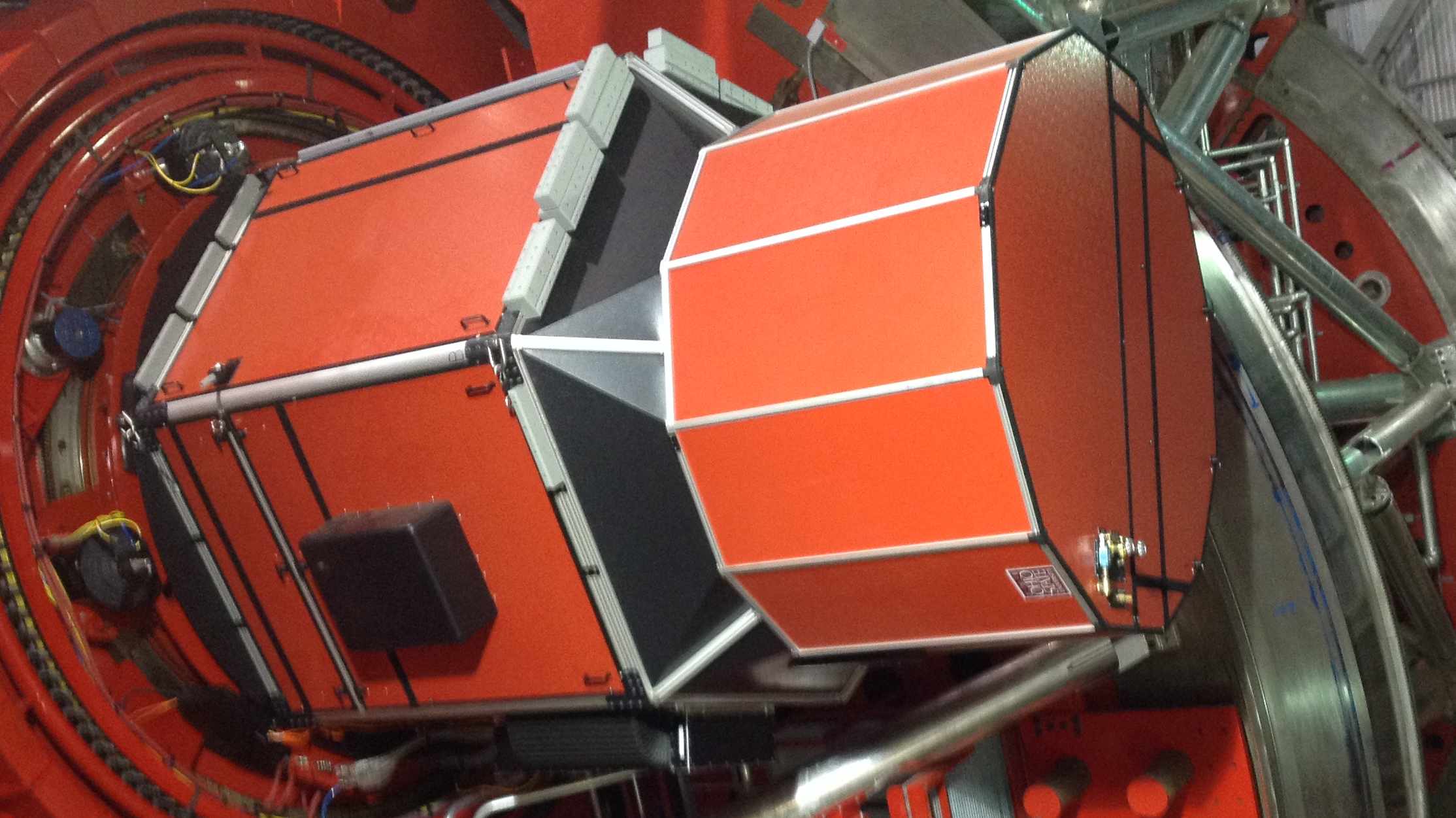 MODS1 and MODS2 (The Multi-Object Double Spectrographs for the Large Binocular Telescope) are a pair of optical spectrographs and imagers mounted at the SX Nasmyth. Each MODS has two channels highly optimized for the Blue and Red portions of the spectrum. Light can go straight through to the blue or the red channels, or directed to both blue and red channels (dual mode). With a 6 arcminute square field of view it is capable of long-slit and multi-slit spectroscopy as well as imaging in the ugriz bands from 0.33 to 1.1 µm. All modes currently work in seeing-limited mode.
MODS1 and MODS2 (The Multi-Object Double Spectrographs for the Large Binocular Telescope) are a pair of optical spectrographs and imagers mounted at the SX Nasmyth. Each MODS has two channels highly optimized for the Blue and Red portions of the spectrum. Light can go straight through to the blue or the red channels, or directed to both blue and red channels (dual mode). With a 6 arcminute square field of view it is capable of long-slit and multi-slit spectroscopy as well as imaging in the ugriz bands from 0.33 to 1.1 µm. All modes currently work in seeing-limited mode.
More information is available here and here (manual).
| MODE | FOV | Scale | Resolution | Blue | Red | Dual |
|---|---|---|---|---|---|---|
| Imaging | 6'x 6' | 0.12"/pix | -- | ug (sloan) | riz (sloan) | ugriz (sloan) |
| Grating longslit-MOS | 6'x 6' | 0.12"/pix | 2000 | 3300-6000 | 5000-10000 | 3200-10000 |
| Prism longslit-MOS | 6'x 6' | 0.12"/pix | 150-500 | 3300-6000 | 5000-10000 | 3200-10000 |
PEPSI
 PEPSI (Postdam Echelle Polarimetric and Spectroscopic Instrument) is a high-resolution spectrograph located in the telescope pier, inside a stabilized chamber. PEPSI has two spectrograph cameras that are equipped with a monolithic 10.3kx10.3k CCD, with 9 µm pixels. The entire spectral range from 383 to 907 nm can be covered in three exposures. Spectral resolution up to R=250.000 can be achieved. PEPSI can be used also as a spectropolarimeter.
PEPSI (Postdam Echelle Polarimetric and Spectroscopic Instrument) is a high-resolution spectrograph located in the telescope pier, inside a stabilized chamber. PEPSI has two spectrograph cameras that are equipped with a monolithic 10.3kx10.3k CCD, with 9 µm pixels. The entire spectral range from 383 to 907 nm can be covered in three exposures. Spectral resolution up to R=250.000 can be achieved. PEPSI can be used also as a spectropolarimeter.
More information is available here. Two summary tables of the PEPSI capabilities are available below.
| Fiber Diameter (µm) | Sky diameter (") | Resolution | Spec. cov. (nm) |
|---|---|---|---|
| 100 | 0.74 | 250,000 | 383-907 |
| 200 | 1.5 | 130,000 | 383-907 |
| 300 | 2.3 | 50,000 | 383-907 |
| Fiber Diameter (µm) | Sky diameter (") | Resolution | Spec. cov. (nm) |
|---|---|---|---|
| 200 | 1.5 | 130,000 | 450-907 |
LUCI1, LUCI2
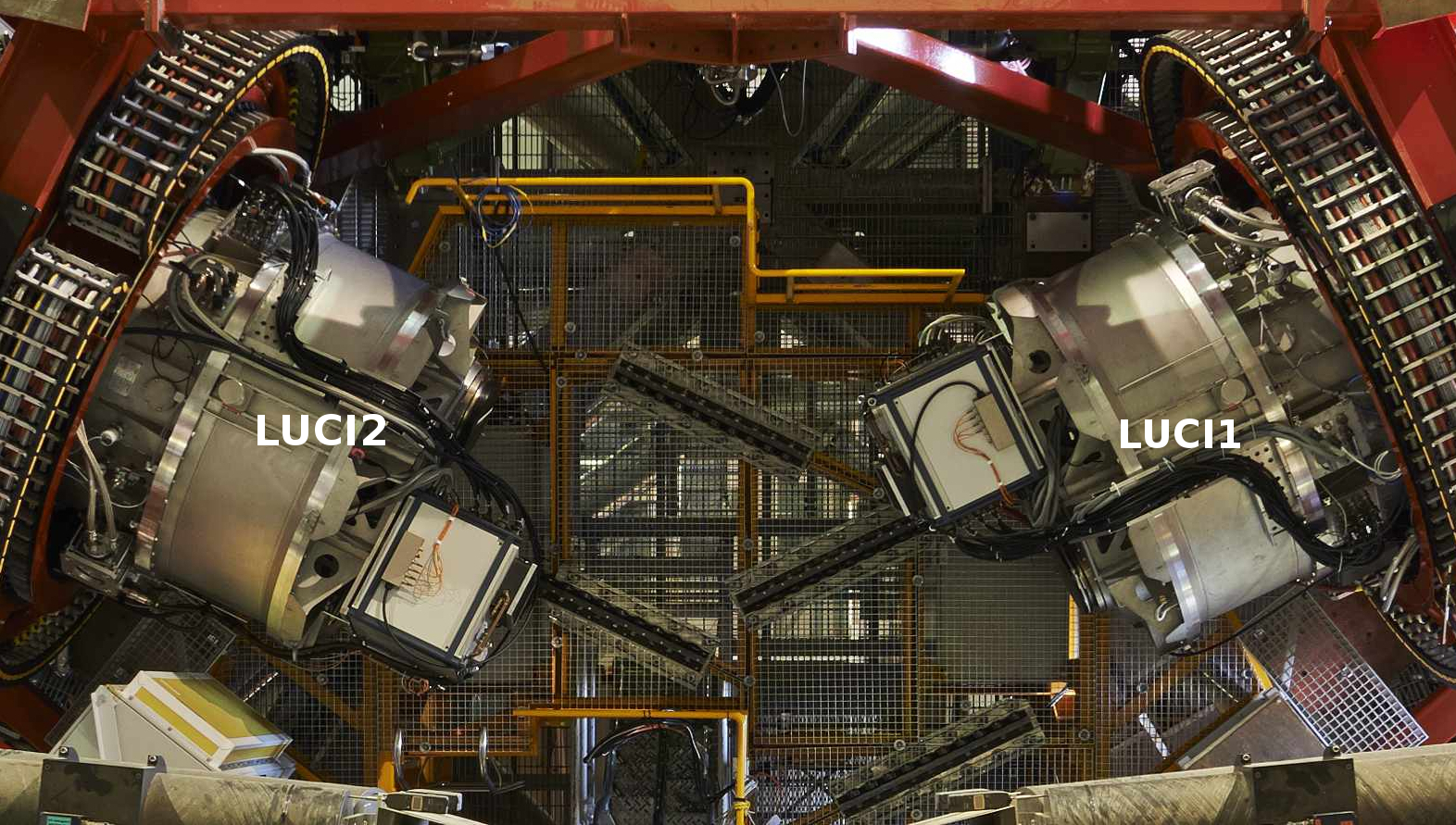 LUCI1 and LUCI2, (formerly known as LUCIFER) are a pair of near-IR spectrographs and imagers operating in the wavelength range 0.89 µm (LUCI1) or 0.96 µm (LUCI2) to 2.44 µm. Each LUCI is equipped with wide field and narrow field cameras. The wide field camera can operate as imager or spectrograph (LSS and MOS) in 3 modes: seeing limited, ESM or ground layer AO with ARGOS. The narrow field camera can operate as imager (spectroscopy is planned) in single conjugate AO mode with SOUL only. For more information, please visit the official LBTO LUCI web page (manual here) and the INAF Arcetri's web page dedicated to the Science with SOUL.
LUCI1 and LUCI2, (formerly known as LUCIFER) are a pair of near-IR spectrographs and imagers operating in the wavelength range 0.89 µm (LUCI1) or 0.96 µm (LUCI2) to 2.44 µm. Each LUCI is equipped with wide field and narrow field cameras. The wide field camera can operate as imager or spectrograph (LSS and MOS) in 3 modes: seeing limited, ESM or ground layer AO with ARGOS. The narrow field camera can operate as imager (spectroscopy is planned) in single conjugate AO mode with SOUL only. For more information, please visit the official LBTO LUCI web page (manual here) and the INAF Arcetri's web page dedicated to the Science with SOUL.
| MODE | FOV | SCALE | Resolution | |
|---|---|---|---|---|
| SEEING LIMITED | Imaging | 4'x4' | 0.12"/pix | -- |
| Long Slit/MOS | 4'x2' | 1"/slit | 1000-5000 | |
| SOUL - Single conjugated AO (Down to diffraction limit) |
Imaging | 30"x30" | 0.015"/pix | -- |
| Long Slit | 30"x30" | 0.13"/slit | 10000-40000 | |
| ESM (Seeing enhancer: factor 1.5-2) |
Imaging | 4'x4' | 0.12"/pix | -- |
| Long Slit/MOS | 4'x2' | 0.50"/slit | 2000-11000 | |
| ARGOS (Seeing enhancer: factor 2-3) |
Imaging | 4'x4' | 0.12"/pix | -- |
| Long Slit/MOS | 4'x2' | 0.25"/slit | 4000-17000 |
LBTI
 The Large Binocular Telescope Interferometer (LBTI) is a high spatial resolution instrument developed for coherent imaging and nulling interferometry using the 14.4 m baseline of the 2x8.4m LBT. The unique telescope design, comprising of the dual apertures on a common elevation-azimuth mount, enables a broad use of observing modes. The full system is comprised of dual adaptive optics systems, a 1-5 µm near-infrared phasing camera (called LMIRCam) and an 8-13 µm camera (called NOMIC). Overview of the instrument is here.
The Large Binocular Telescope Interferometer (LBTI) is a high spatial resolution instrument developed for coherent imaging and nulling interferometry using the 14.4 m baseline of the 2x8.4m LBT. The unique telescope design, comprising of the dual apertures on a common elevation-azimuth mount, enables a broad use of observing modes. The full system is comprised of dual adaptive optics systems, a 1-5 µm near-infrared phasing camera (called LMIRCam) and an 8-13 µm camera (called NOMIC). Overview of the instrument is here.
LMIRCAM
LMIRCam (LBT Mid-InfraRed interferometric Camera) is a camera and coronagraph built to exploit the sensitivity of LBTI. It is available in 3 modes: Single and dual aperture non-coherent direct imaging, Single and Dual aperture nonredundant mask imaging, Single aperture apodizing phase plate coronagraphy. It is optimized for 3-5 µm but can be suited for shorter wavelenghts. The field of view is 11"x11".
More information is available here.
NOMIC
NOMIC is a mid-infrared (8-13 μm) camera that uses a 1024x1024 array with a 30 μm pitch which corresponds to 0.018 arc-second pixels on the sky providing a spatial resolution at a 10 μm wavelength of 0.27 arc-seconds for a single 8.4 meter LBT aperture and of 0.10 arcseconds for Fizeau interferometry with the dual apertures.
More information is available here.
SHARK-VIS
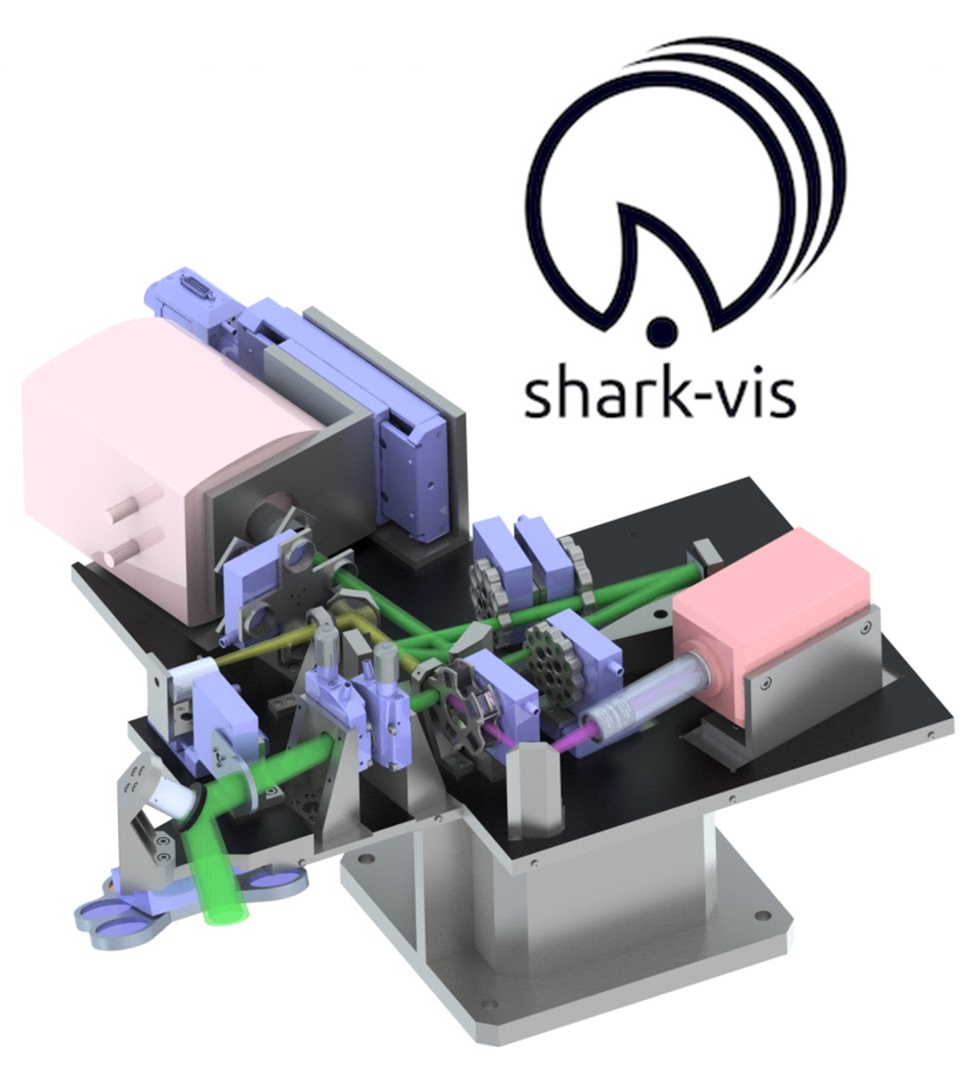 SHARK-VIS is a high-contrast and coronagraphic instrument, fed by the SOUL
AO system, which provides high-angular-resolution and high-contrast capabilities both in narrow and broad visible bands. It is equipped with a high-cadence low-noise sCMOS camera with a pixel scale of 6.5 mas/pix, which is adequate to Nyquist sample the diffraction limited PSF of the LBT telescope up to 450nm. The instrument adopts a fast-imaging approach, using short DITs to limit the PSF smearing due to atmospheric AO residuals and telescope jitter, thus being optimized for extremely high-angular-resolution and high-contrast imaging in a field of a few arcseconds. The instrument focal plane is always tracking the telescope pupil, hence derotation is performed post-facto, by processing the acquired stream of consecutive images. Because the SOUL wavefront sensor operates in the optical, SHARK-VIS always shares part of the visible light with the AO system. A series of input dichroics allows the observer to split the light between the two systems in different ways so as to optimize both the AO performance and the scientific observations.
Overview of the instrument is here.
SHARK-VIS is a high-contrast and coronagraphic instrument, fed by the SOUL
AO system, which provides high-angular-resolution and high-contrast capabilities both in narrow and broad visible bands. It is equipped with a high-cadence low-noise sCMOS camera with a pixel scale of 6.5 mas/pix, which is adequate to Nyquist sample the diffraction limited PSF of the LBT telescope up to 450nm. The instrument adopts a fast-imaging approach, using short DITs to limit the PSF smearing due to atmospheric AO residuals and telescope jitter, thus being optimized for extremely high-angular-resolution and high-contrast imaging in a field of a few arcseconds. The instrument focal plane is always tracking the telescope pupil, hence derotation is performed post-facto, by processing the acquired stream of consecutive images. Because the SOUL wavefront sensor operates in the optical, SHARK-VIS always shares part of the visible light with the AO system. A series of input dichroics allows the observer to split the light between the two systems in different ways so as to optimize both the AO performance and the scientific observations.
Overview of the instrument is here.
SHARK-NIR
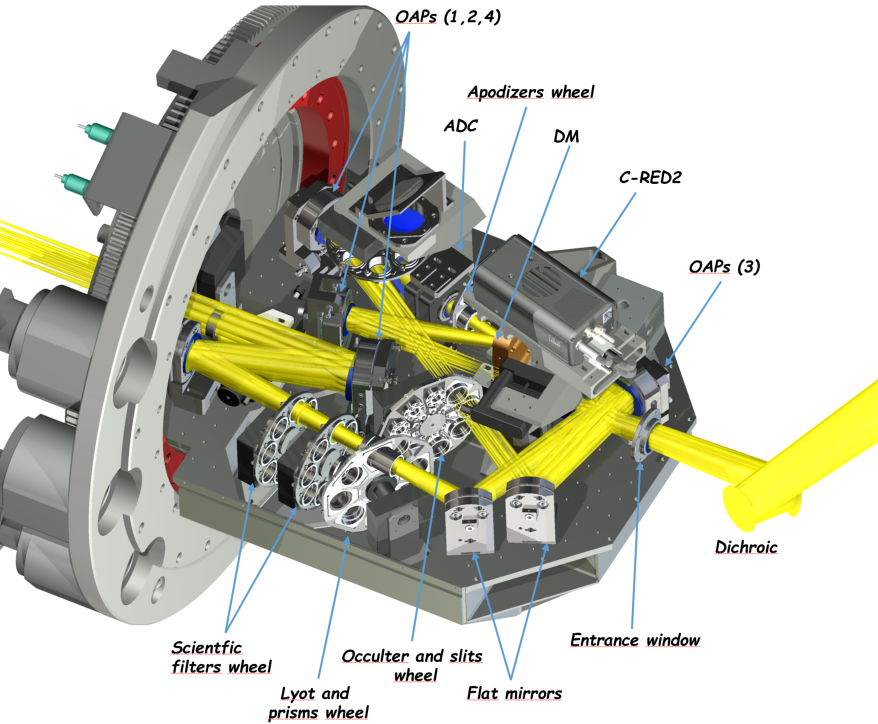 SHARK-NIR is a near-infrared (between 0.95 and 1.7 μm)
high-contrast imager, which provides three different observing modes: coronagraphic imaging, classical imaging and medium resolution spectroscopy. The coronagraphic mode allows to observe with different types of coronagraph: one Gaussian Lyot coronagraph, one four-quadrant-phase-mask (FQPM) coronagraph, one symmetric shaped pupil (SP) coronagraph and two different asymmetric SP coronagraphs. The first two coronagraphs allow observation of a large field-of-view (FOV) with a radius of 9" while the SP coronagraphs have a limited FOV allowing a deeper contrast in the region between 0.1" and 0.3". The Gaussian Lyot coronagraph has been commissioned in the past months and it is currently in use for scientific observations while the other coronagraphs are still in their commissioning phase and are offered on a best-effort basis. Each observing mode allows the use of both wide-band (Y, J and H) and narrow-band (FeII, HeI, Paβ, contJ, contH, NB_H2 and NB_H3) scientific filters. Furthermore, both coronagraphic and classical imaging modes allow observation in dual band imaging with the light from the telescope splitted in two near wavelength images. The possible combinations of filters for the dual-band imaging are: H2-H3, ContJ-Paβ and ContH-FeII. Finally, the long slit spectroscopy (LSS) mode allows to obtain spectra with a resolution of R=100 or R=700 in the same spectral region of the imaging mode. This observing mode has been designed to obtain the spectra of bright companions (contrast of the order of 10-4 to 10-5) at a separation of less than 1" from the host star, and it has been thoroughly tested on stellar companions while testing on lower mass companions is ongoing.
Overview of the instrument is here.
SHARK-NIR is a near-infrared (between 0.95 and 1.7 μm)
high-contrast imager, which provides three different observing modes: coronagraphic imaging, classical imaging and medium resolution spectroscopy. The coronagraphic mode allows to observe with different types of coronagraph: one Gaussian Lyot coronagraph, one four-quadrant-phase-mask (FQPM) coronagraph, one symmetric shaped pupil (SP) coronagraph and two different asymmetric SP coronagraphs. The first two coronagraphs allow observation of a large field-of-view (FOV) with a radius of 9" while the SP coronagraphs have a limited FOV allowing a deeper contrast in the region between 0.1" and 0.3". The Gaussian Lyot coronagraph has been commissioned in the past months and it is currently in use for scientific observations while the other coronagraphs are still in their commissioning phase and are offered on a best-effort basis. Each observing mode allows the use of both wide-band (Y, J and H) and narrow-band (FeII, HeI, Paβ, contJ, contH, NB_H2 and NB_H3) scientific filters. Furthermore, both coronagraphic and classical imaging modes allow observation in dual band imaging with the light from the telescope splitted in two near wavelength images. The possible combinations of filters for the dual-band imaging are: H2-H3, ContJ-Paβ and ContH-FeII. Finally, the long slit spectroscopy (LSS) mode allows to obtain spectra with a resolution of R=100 or R=700 in the same spectral region of the imaging mode. This observing mode has been designed to obtain the spectra of bright companions (contrast of the order of 10-4 to 10-5) at a separation of less than 1" from the host star, and it has been thoroughly tested on stellar companions while testing on lower mass companions is ongoing.
Overview of the instrument is here.


